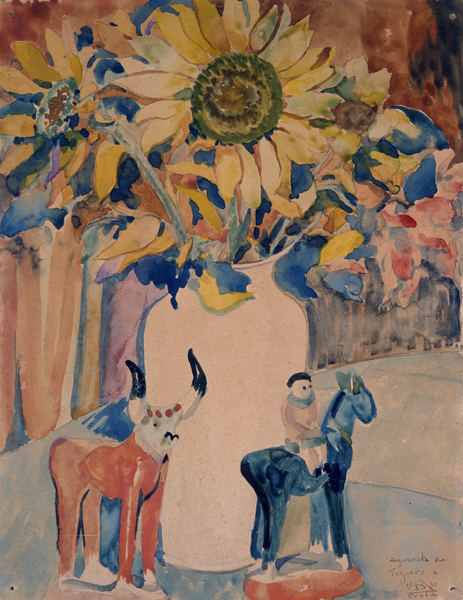
Diogo de Macedo, José Tagarro
s/título
Vila Nova de Gaia, Portugal, 1889 – Lisbon, Portugal, 1959
True to the sculptural tradition of Vila Nova de Gaia (close to Porto), and an early admirer of the sculptor Soares dos Reis (1847-1889), Diogo de Macedo took his first steps in modelling with Fernandes Caldas, a saint sculptor, in the small rural village Mafamude, where he was born. He also attempted to play the trumpet and was interested in guitars, until his brother forced him into an office job, from which he ran away, protected by Teixeira Lopes (1866-1942). This renowned sculptor and teacher convinced the family to let the eleven-year old child follow his wish: to study sculpture at the Academy of Fine Arts in Porto.
Once graduated, in 1911, he headed to Paris. And just like the Azorean sculptor Canto da Maia, Macedo would be deeply influenced by Antoine Bourdelle’s classes at the Académie de la Grande Chaumière and by the discovery of Rodin’s work. A parallel between these two Portuguese artists reveals a common quest for an exotic figurative sculpture, ruled by Symbolist ideas but whose neo-romantic figures were carved as discreet pantomimes of strong emotions, in the serene and classic stylizations advocated by the taste for Antiquity then in vogue – a style made famous by his 1920s group of sculptures, L’Adieu [The Farewell] and Le Pardon [The Pardon].
The economic and personal difficulties Diogo de Macedo had to endure didn’t keep him from visiting Belgium (1913) and from enjoying the bohemian life of Paris, while he obsessively devoted himself to sculpture and painting. His stay at one of the studios most coveted by artists, near Montparnasse, at the 14, Cité Falguière, would later be the subject of an important written memoir (1930), in wich Diogo de Macedo recalls the artists who lived there, such as Amadeo de Souza-Cardos, the Japanese Tsuguharu Foujita, or the Italian Amedeo Modigliani, the main influence in his own drawings.
Despite living in Paris, Macedo’s works began to be appreciated in Portugal, with constant exhibitions both in Porto and Lisbon from 1912 on, becoming all the more frequent when he moved back to Porto, returning from Paris a month after the onset of World War I. Macedo would only go back to France four years later, accompanied in a long tour by Ana Sotto-Mayor, whom he had married against her family’s will, settling again in Paris in 1921. This was a period of intense work, exhibitions, travels and social events. At the same time, Macedo prepared an album on Portuguese traditional costums for the illustrated periodical Ilustração Portuguesa and organized the Exposição dos 5 Independentes [Exhibition of the 5 Independents] (1923) in Lisbon, which gathered a group of Portuguese artists living in Paris that opposed the artistic conservatism of their native country. Taking advantage of an era of economic growth, Macedo moved permanently to Lisbon (1926) and intensified his critical interventions throughout the following decade, writing in journals and magazines, wherein some of the most vivid descriptions and memories of that artistic period can be found. In the capital, Macedo was noted for his busts and portraits of celebrities, like actors (António Menano; Beatriz Costa), writers (Camilo Castelo Branco; Antero de Quental; Florbela Espanca; António Botto) or painters (Mário Eloy; Sarah Affonso), but also for one of his last works, in 1940, the four Tagus Nymphs of the monumental fountain at the Alameda Afonso Henriques, in Lisbon.
When Macedo lost his wife, in 1941, he abandoned sculpture altogether. From that moment on, he devoted himself entirely to the preservation, study and exhibition of the arts, taking on what he described as “missions of art”. Still in this year, he made his debut as a conference speaker, and began to publish biographies of artists, literary criticism, studies and essays, prefacing exhibition catalogues and integrating juries and commissions. After assuming the direction of the National Museum of Contemporary Art (now Chiado Museum) in 1944 his official functions became ever more frequent, being invited by the Ministry of Colonies to conceive and accompany a touring exhibition of modern art in Angola and Mozambique (1948), heading a Portuguese Cultural Week in Santiago de Compostela (1949) or, in the next decade, travelling to Brasil in a study trip and visiting the Island of São Miguel, in the Azores, to organize the procedures of heritage classification. Nevertheless, Diogo de Macedo would still at times show his artistic work, in important international venues as the Venice Biennale in 1950 or in the Portuguese Pavilion at the Brussels World’s Fair in 1958.
Afonso Ramos
February 2011